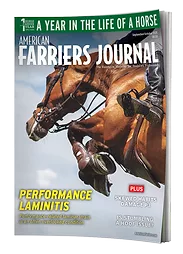Smokey, your client’s 20-something gray Quarter Horse, has given them years of great trail riding. All the neighborhood kids learned to ride on Smokey, and they still dress him up like a reindeer for the community Christmas parade. He doesn’t move as effortlessly as he used to, however, and everything about him has slowed down a bit, including how fast his hooves grow. Your clients are thinking about skipping some farrier visits; after all, this horse isn’t doing much work, so he probably doesn’t need to be trimmed as often, right?
This kind of thinking is understandable, as some older horses may show less hoof growth than younger equines. However, farriers should explain to their clients that all hooves grow more rapidly at the toe than in the heel area, and over time, this difference in growth rate tips the pastern back, changing the stress on tendons and other joint structures. For older horses that may have arthritis or chronic discomfort from old injuries, regular trimming minimizes this strain and discomfort.
Owners should remind the farrier of a senior horse’s age so that this professional can be aware of possible stiffness or pain that may keep the horse from cooperating. Farriers can adapt their work by picking up legs slowly, allowing them to stretch and bend gradually. The farrier can also work close to the horse rather than pulling a leg too far from the body; lifting the hoof no higher than necessary; and setting each hoof down gently. Trimming two hooves, putting the older horse away and trimming another horse, and then finishing the last two hooves is a good way to give an arthritic horse a break. Regular hoof trimming is just as important for senior equines as for their younger barn mates.
Some owners give their senior horses phenylbutazone (bute) before farrier visits. If this medication is used, Bryan Waldridge, staff veterinarian at Kentucky Equine Research, suggests farriers advise owners that oral bute takes about 8-12 hours to develop its full pain-relieving effect. For this reason, the medication should be given to the horse in the evening for a next-morning farrier visit, or early in the morning for a late afternoon appointment.
Good nutrition is important for the development of healthy hoof tissue, and the use of a hoof supplement will guarantee that the older horse has all the nutrients necessary to keep hooves in good shape. Free exercise is also a good idea for minimizing the development of stiffness and arthritic changes. Owners should pick out the hooves of older horses daily to enforce the habit of allowing the feet to be lifted and handled.






